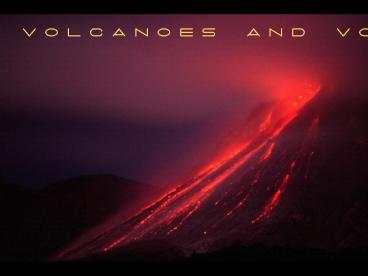volcanoes and volcanism PowerPoint PPT Presentation
1 / 39
Title: volcanoes and volcanism
1
volcanoes and volcanism
2
volcanism
process that results in expulsion of molten
rock on surface
lava and hot particles (pyroclasts) erupt and
build volcanoes
examples
in any given year about 50 eruptions
occur --about 600 volcanoes have erupted 200
times in past 2,000 years--
3
famous example noise heard around the world
Krakatoa 1883 eruption
Indonesia
major motion picture (whats wrong?)
-- was 792 meters -- left a hole 304 meters
deep -- caused a tsunami that killed 100,000
people -- generated ash cloud that blocked
sunlight -- heard noise over 3000 miles away
baby Krakatoa grows at 5 inches/week
4
volcanism benefits
atmosphere -- created from gases released by
magmas
hydrosphere -- produced from condensation of
water vapor released by volcanism
biosphere -- has positive and negative effects
lava flows and ash weather to produce fertile
soils
violent eruptions can destroy nearly all life
in their paths
large amounts of ash and volcanic gases in
atmosphere can trigger rapid climate changes and
lead to mass extinctions
other benefits --
added real estate
geothermal energy
spectacular scenery
5
living with volcanoes
mythology Pele (Hawaii) exiled from Tahiti by
her father because of her temper
geothermal energy Iceland source of inexpensive
energy
6
volcanic catastrophes Pompeii, Tambora,
Martinique, Nyos
Pompeii 79 AD Vesuvius
Martinique 1902 Pele
Lake Nyos 1986 CO2 gas released hugged ground
Tambora 1815 90,000 killed larger than
Krakatoa year with no summer
7
not all volcanoes are the same!
contrast Mt. St. Helens with Hawaii
Why?
violence of eruptions controlled by
dissolved gases in the magma --water vapor,
carbon dioxide, sulfur dioxide, etc.
and ease/difficulty by which they escape
viscosity of the magma (fluids resistance to
flow) -- silica content higher silica has
higher viscosity -- temperature cooler lavas
have higher viscosities -- dissolved gases
more dissolved gases yield lower viscosities
8
investigation of volcanism
rocks, gases, and events observed at modern
eruptions are compared to similar ancient
lavas to infer past activity
composition of rocks (silica content)
9
extrusive textures
glassy without mineral crystals
obsidian
fine-grained (aphanitic) crystals lt 1 mm
basalt
porphyritic large crystals in a
matrix of small crystals
andesite
10
extrusive textures
vesicular frothy (trapped gas bubbles)
pumice
fragmental particles blasted apart by eruption
dust and ash ( lt 2 mm)
cinders ( 2 - 64 mm)
blocks and bombs ( gt 64 mm)
pyroclasts -- hot particles
cinder cone
11
obsidian
12
andesite (porphyritic)
13
andesite under microscope note small/big crystals
14
vesicular basalt
vesicles represent gas bubbles
15
pumice (frothy)
16
volcanic bombs rapidly cooled magma thrown
from vent
17
tuff rock composed of fine-grained pyroclastic
material
18
tuff
19
volcanic landforms
vent opening through which lava erupts
crater depression over the vent
at the summit of the volcano
caldera depression much larger than
original crater ( gt 1 km)
20
Cascade volcanoes
volcanic chain in Pacific Northwest from northern
California to British Columbia
last eruption was Mount Saint Helens in
1980 (andesitic)
21
Gary Rosenquist Photo Sequence - Mt. St.
Helens, May 18, 1980(occurred in three minutes)
22
Mt. St. Helens eruption column - May 18, 1980
from USGS http//vulcan.wr.usgs.gov/
23
eruption cloud in first 13 minutes
thickness of ash in cm
24
Mt. St. HelensMay 18, 1980 devastation
25
volcano after May 18, 1980 with lava dome inside
crater
From USGS http//vulcan.wr.usgs.gov/
26
what happened at Mt. St. Helens?
landslide uncorked magma chamber, removing load
and causing eruption
27
characteristics of Mt. St. Helens?
andesitic (intermediate silica)
dome-forming magma too viscous to flow from
crater and solidifies at vent
generated volcanic mudflows
can lead to culminating explosions and caldera
formation
28
what is a caldera?
large depression ( gt 1 km diameter) at top of
volcano
caldera
sometimes they fill with water
29
Crater lake - Wizard Island - 5 kBP Eruption Mt.
Mazama
Crater Lake and Wizard Island, Oregon
30
caldera formation from eruption of ancient Mt.
Mazama
eruption begins
eruption expels large volumes of magma
ground collapses into empty chamber
steam explosions produce water
31
map that shows features inside lakevolcanic
coneslandslide
32
caldera formation associated with large eruptions
thickness of ash from Mt. Mazama eruption
33
another caldera-forming eruption (700,000 years
ago)
maximum extent of Bishop Tuff (ash produced)
34
yet anotherYellowstone (630,000 and 2,000,000
years ago)
Yellowstone ash
35
example of ash (not from Yellowstone)
Montserrat 2003
36
Mt. St. Helens, Vesuvius, Pele, most caldera
collapses
produce pyroclastic eruptions
viscous, gas-rich magma
pyroclasts -- pyro fire clasts pieces
hot dome collapses, producing pyroclastic flows
particles ejected into atmosphere and fall
back, generating pyroclastic flows
Mt. Pinatubo, Phillipines
37
(No Transcript)
38
devastation of St. Pierre, Martinique by
pyroclastic flows
over 40,000 killed 1 survivor
1902
39
Plymouth, Montserrat - Oct. 1997
the capital city had to be rebuilt

